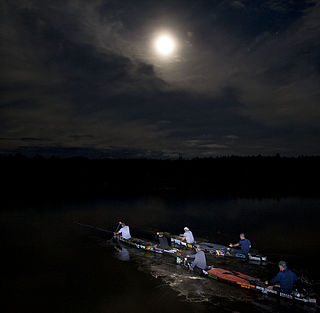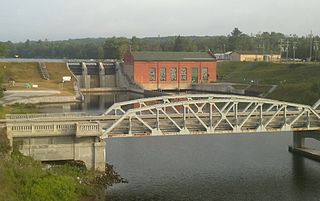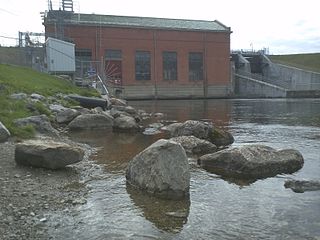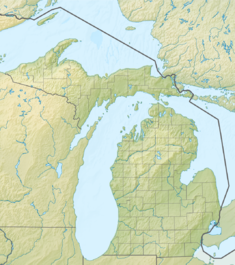
Oscoda is an unincorporated community in the U.S. state of Michigan located on the northern side of the Au Sable River where it enters Lake Huron. The community of Au Sable is on the other side of the river. Oscoda is in Oscoda Township in Iosco County, and not in Oscoda County, which is to the northwest. Oscoda was incorporated as a village in 1885, but disincorporated in 1919 after forest fires devastated the area. The 1990 census population was 1,061, although 3,000 personnel were stationed at nearby Wurtsmith Air Force Base. Oscoda is a census-designated place (CDP) for statistical purposes. As of the 2000 census, the population was 992, and in 2010 the population was 903. The post office at Oscoda first opened with the name AuSable on September 23, 1856. The name changed to Oscoda on July 1, 1875.

The Au Sable River in Michigan, United States runs approximately 138 miles (222 km) through the northern Lower Peninsula, through the towns of Grayling and Mio, and enters Lake Huron at the town of Oscoda. It is considered one of the best brown trout fisheries east of the Rockies and has been designated a blue ribbon trout stream by the Michigan Department of Natural Resources. French Rivière au sable means "Sand River." A 1795 map calls it the Beauais River.

Iosco County is a county in the U.S. state of Michigan; its eastern border is formed by Lake Huron. As of the 2010 census, the population was 25,887. The county seat is Tawas City.

Grayling ( GRAY-LEENG) is the only city and county seat of Crawford County in the U.S. state of Michigan. The population was 1,884 at the 2010 census. The city is surrounded by Grayling Charter Township, but the two are administered autonomously.

Mio is an unincorporated community and census-designated place (CDP) in Oscoda County in the U.S. state of Michigan. It is the county seat of Oscoda County. As of the 2010 census, the CDP had a population of 1,826.

The Mangla Dam is a multipurpose dam situated on the Jhelum River in the Mirpur District of Azad Jammu and Kashmir, Pakistan. It is the sixth-largest dam in the world. The village of Mangla, which sits at the mouth of the dam, serves as its namesake. In November 1961, the project's selected contractors were revealed; it was announced that Binnie & Partners, a British engineering firm, was going to serve as the lead designers, engineers, and inspectors for the construction of the dam. The project was undertaken by a consortium known as the Mangla Dam Contractors, which consisted of eight American construction firms sponsored by the Guy F. Atkinson Company based in South San Francisco, California.

The Crotty Dam, also known during construction as the King Dam, or the King River Dam on initial approval, is a rockfill embankment dam with a controlled and uncontrolled spillway across the King River, between Mount Jukes and Mount Huxley, located in Western Tasmania, Australia.

Lake Chelan Dam officially known as the Lake Chelan Hydroelectric Project is located approximately 32 miles (51 km) north of the city of Wenatchee in Chelan County, near the geographic center of Washington state. The dam is located at the lower or southeasterly end of 50.4 miles long Lake Chelan, and is within the limits of the city of Chelan. The powerhouse is located near the community of Chelan Falls. The reservoir has 677,400 acre-feet (835,600,000 m3) of usable water storage. The 10-year average generation for the Project is 365,000 megawatt hours.
M-65 is a 103.176-mile-long (166.046 km) state trunkline highway in the US state of Michigan. The highway runs between termini on US Highway 23 (US 23) near Omer and Rogers City in the northeastern Lower Peninsula of the state. M-65 runs inland through several small communities in the region, passing through forests and fields along its course. M-65 crosses several watercourses, including the Au Sable River where it runs along the River Road National Scenic Byway. The region also includes the Huron National Forest and the Mackinaw State Forest areas.

Lumberman's Monument is a monument dedicated to the workers of the early logging industry in Michigan. Standing at 14 feet, the bronze statue features a log surrounded by three figures: a timber cruiser holding a compass, a sawyer with his saw slung over his shoulder, and a river rat resting his peavey on the ground. The granite base of the statue is engraved with a memorial that reads "Erected to perpetuate the memory of the pioneer lumbermen of Michigan through whose labors was made possible the development of the prairie states." It is also inscribed with the names of the logging families who dedicated their time and efforts to the industry in the area. It was built in 1931, dedicated in 1932 and is managed by the USDA Forest Service. It is located in the northeastern part of the Lower Peninsula of Michigan along the Au Sable River within Huron-Manistee National Forests. Access to the park is on River Road, which intersects M-65 west of Oscoda, Michigan. Monument Road, from East Tawas, also leads directly to the monument, which is in Oscoda Township in Iosco County. The monument is part of the River Road Scenic Byway, a 22-mile (35 km) drive between Oscoda and South Branch that runs parallel with the beautiful Au Sable River. It is a designated National Scenic Byway.

The Au Sable River Canoe Marathon, presented by Consumers Energy, is an annual 120 mi (193 km) canoe race in Michigan from Grayling to Oscoda. Nicknamed and known simply as "The Marathon," it first ran in 1947, and is perhaps the oldest marathon canoe race in the United States, and is the longest, non-stop, canoe-only race in North America. The race has been billed as "The World's Toughest Spectator Race" as many of the spectators follow the racers overnight down the full 120 miles (190 km) to the finish.

Croton Dam is an earth-filled embankment dam and powerplant complex on the Muskegon River in Croton Township, Newaygo County, Michigan. It was built in 1907 under the direction of William D. Fargo by the Grand Rapids - Muskegon Power Company, a predecessor of Consumers Energy. The 40-foot-high (12 m) dam impounds 7.2 billion U.S. gallons (6 billion imp. gal/27 billion L) of water in its 1,209-acre (489 ha) reservoir and is capable of producing 8,850 kilowatts at peak outflow. It was listed on the National Register of Historic Places in 1979.
The River Road National Scenic Byway is a National Scenic Byway and National Forest Scenic Byway in the US state of Michigan. This 23+1⁄2-mile-long (37.8 km) byway follows M-65 and River Road; it extends eastward into the Huron National Forest and ends in the historic community of Oscoda near Lake Huron. The road parallels the historic Au Sable River which has historically been a major transportation route for floating Michigan's giant white pine from the forest to the saw mill towns on Lake Huron. Along its course, the roadway offers access to several recreational areas as well as the local scenery. The section of the River Road that follows M-65 was added to the State Trunkline Highway System in the 1930s. The River Road was given National Forest Scenic Byway status in 1988, and National Scenic Byway status in 2005.

Five Channels Dam is a hydro-electric dam on the Au Sable River in Michigan.

The Triple Crown of Canoe Racing is a canoe marathon series consisting of:

Cooke Dam is a hydro-electric dam on the Au Sable River in Michigan. It was listed on the National Register of Historic Places in 1996 as the Cooke Hydroelectric Plant.

Iargo Springs in Oscoda, Michigan, features several viewing decks and a boardwalk path through the natural springs. Natural springs are formed from water that naturally flows to the surface from underground. The natural springs can be accessed from the road by stairs leading down to the Au Sable River. Man-made barriers pool the springs and create small waterfalls. The wooden boardwalk stretches over 1,000 feet (300 m) as it winds through the natural springs.

The Ford Lake Dam is an earthen, multi-arch hydroelectric gravity dam and powerhouse crossing the Huron River in Ypsilanti Charter Township in Washtenaw County in the U.S. state of Michigan. The dam was constructed in 1931–1932 and created the Ford Lake reservoir at 975 acres (395 ha).
Minnesota Scenic Byways are a system of roads in the U.S. state of Minnesota which pass through areas of scenic, cultural, or recreational significance. There are currently 22 scenic byways in the system with a total length of 2,948 miles (4,744 km). Eight of these byways are also designated as National Scenic Byways, and the North Shore Scenic Drive is further designated as an All-American Road.

Mio Dam is a hydro-electric dam located on the Au Sable River in Michigan capable of generating 4.96 MW of electric power. It was the 4th of 6 dams built by Consumers Power between 1906 and 1924 along the Au Sable River and is the furthest upstream of the six. The dam was completed in 1916. The Mio Hydroelectric Plant consists of an embankment on each side connected by a spillway. Located North of the spillway is the powerhouse and outdoor substation. Public access to Mio Pond is provided via a boat ramp maintained by Consumers Energy, and portage facilities are also provided allowing canoes and kayaks access to bypass the dam. Portage the dam on the right using the cement stairs then carry down a gravel road with a canoe slide on the down river side of the dam. The Mio Dam powerhouse continues to operate with the same turbines and generators that were installed over a century ago.


















